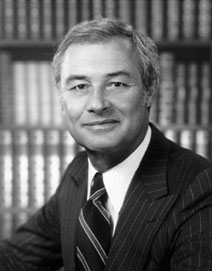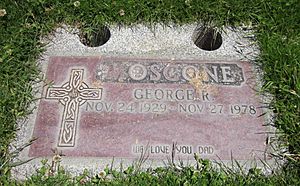George Moscone facts for kids
Quick facts for kids
George Moscone
|
|
|---|---|
 |
|
| 37th Mayor of San Francisco | |
| In office January 8, 1976 – November 27, 1978 |
|
| Preceded by | Joseph Alioto |
| Succeeded by | Dianne Feinstein |
| Member of the California Senate | |
| In office January 2, 1967 – January 8, 1976 |
|
| Preceded by | Harold Thomas Sedgwick |
| Succeeded by | John Francis Foran |
| Constituency | 10th district (1967–1971) 6th district (1971–1976) |
| Member of the San Francisco Board of Supervisors | |
| In office 1963–1966 |
|
| Personal details | |
| Born |
George Richard Moscone
November 24, 1929 San Francisco, California, U.S. |
| Died | November 27, 1978 (aged 49) San Francisco, California, U.S. |
| Cause of death | Assassination by gunshot |
| Resting place | Holy Cross Cemetery |
| Political party | Democratic |
| Spouse |
Gina Bondanza
(m. 1954) |
| Children | 4; including Jonathan |
| Education | |
| Military service | |
| Allegiance | United States |
| Branch/service | United States Navy |
| Years of service | 1953–1956 |
| Battles/wars | Korean War |
George Richard Moscone (born November 24, 1929 – died November 27, 1978) was an American lawyer and a Democratic politician. He served as the 37th mayor of San Francisco, California, from January 1976 until his death in November 1978. People called him "The People's Mayor." He worked to make City Hall and its committees more diverse. He appointed African Americans, Asian Americans, and gay people to important roles. Before becoming mayor, Moscone was a State Senator in California from 1967. In the Senate, he was the Majority Leader. George Moscone is remembered for supporting civil rights and progress for all people.
Contents
Early Life and Education
George Moscone was born in San Francisco's Marina District. His family came from Italy. His father, George Joseph Moscone, worked as a Correction Officer. His mother, Lena, was a homemaker. She later worked to support herself and George after she and his father separated.
Moscone went to St. Brigid's school and then St. Ignatius College Preparatory. He was a great debater and a star basketball player. He earned a basketball scholarship to the College of the Pacific. He played basketball for the Tigers and earned a degree in Sociology in 1953.
After college, Moscone studied law at University of California, Hastings College of the Law. He received his law degree there. In 1954, he married Gina Bondanza, whom he had known since she was young. They had four children together. After serving in the United States Navy, Moscone started his own law practice in 1956.
Political Career
As a young lawyer, Moscone became good friends with John L. Burton, who later became a member of the U.S. House of Representatives. John's older brother, Phillip Burton, who was in the California State Assembly, encouraged Moscone to run for a political seat in 1960. Although he lost that election, Moscone won a seat on the San Francisco Board of Supervisors in 1963.
On the Board of Supervisors, Moscone was known for defending people who were poor, racial minorities, and small business owners. He also helped stop a plan to build a freeway that would have cut through Golden Gate Park.
California State Senator
In 1966, Moscone ran for and won a seat in the California State Senate. He represented San Francisco County. Moscone quickly became a rising star in the California Democratic Party. He was part of a group of progressive politicians in San Francisco. Soon after being elected, his party chose him to be the Majority Leader.
He was reelected to the State Senate in 1970 and again in 1974. He helped pass a law to create a school lunch program for students in California. In 1974, Moscone thought about running for governor but decided not to. He also supported rights for gay people early on.
Mayor of San Francisco
On December 19, 1974, Moscone announced he would run for Mayor of San Francisco. In a close election in November 1975, Moscone came in first. He then faced a runoff election in December against a more conservative candidate. Moscone won by less than 5,000 votes. Other liberal leaders also won top city jobs that year.

Moscone's mayoral campaign relied on many volunteers. Some came from groups like Glide Methodist Memorial Church and Delancey Street. The Peoples Temple, which was known as a church promoting equality, also helped. There were claims that the Peoples Temple helped Moscone win by having people vote multiple times. After the Peoples Temple's help in his close victory, Moscone appointed their leader, Jim Jones, to lead the San Francisco Housing Commission.
During his first year as Mayor, Moscone worked to keep the San Francisco Giants baseball team from moving. He also supported a citywide vote to change how the Board of Supervisors was elected. Moscone was the first mayor to appoint many women, gay people, and racial minorities to city committees. In 1977, he appointed the first openly gay woman and the first Black woman as Commissioners on the San Francisco Commission on the Status of Women. Moscone also appointed Charles Gain as the head of the San Francisco Police Department.
In April 1977, Moscone supported a group of over 100 people with disabilities. They occupied San Francisco's Federal Building for 25 days, demanding their civil rights. This event became known as the 504 Sit-in. While federal officials tried to make the protesters leave, Mayor Moscone visited them. He even arranged for showers and towels to be brought in. Moscone's support helped the protest succeed. This event helped lead to the Americans with Disabilities Act (ADA) being passed later.
In 1977, Moscone easily won a special election to keep his job. This was a big win for him. That year, San Francisco voters also approved a new system for electing the Board of Supervisors by district. In November 1977, the city held its first district elections. Among those elected were the city's first openly gay Supervisor, Harvey Milk, and other diverse leaders.
Controversy and the Peoples Temple
In August 1977, after Housing Commission Chairman Jim Jones left for Jonestown due to media attention, Moscone announced his office would not investigate Jones and the Peoples Temple. Later, former Temple members told The New York Times that the Temple had arranged for members to be bused into San Francisco to vote in the election. Some members said they were not registered to vote in San Francisco, and that Jones influenced elections.
Assassination
In late 1978, Dan White resigned from the Board of Supervisors. This meant Mayor Moscone could choose White's replacement. This choice could change the balance of power on the Board. People who wanted a more conservative approach convinced White to change his mind. White then asked Moscone to appoint him back to his old seat.
Moscone first seemed willing to consider it. However, more liberal city leaders, including Supervisor Harvey Milk, urged him not to. Moscone finally decided not to appoint White. On November 27, 1978, three days after Moscone's 49th birthday, White went to San Francisco City Hall. He wanted to make one last plea for the appointment. White snuck into City Hall through a basement window to avoid metal detectors. He carried his old police gun. When Moscone agreed to talk with him privately, White shot and killed Moscone. White then also killed Harvey Milk.
Dianne Feinstein, who was President of the Board of Supervisors, became the city's new mayor. Six thousand people attended a service for Moscone at St. Mary's Cathedral.
Dan White later turned himself in to the police. During his murder trial, his lawyers argued he was severely depressed. They claimed his depression was shown by his eating a lot of Twinkies and other junk foods. This became known as the "Twinkie defense." White was found guilty of a lesser crime, manslaughter. This light sentence made many people angry. It led to a large riot in San Francisco, where police cars were set on fire. White was released from prison and died shortly after in 1985.
Legacy
George Moscone is buried at Holy Cross Cemetery in Colma, California.
Several places are named in his honor. These include the Moscone Center, which is San Francisco's largest convention center, and the Moscone Recreation Center. Schools are also named after him and Harvey Milk, such as George Moscone Elementary and Harvey Milk Elementary.
Moscone's most important legacy is how he made San Francisco City Hall more open and diverse. He appointed people from all parts of the population, including minorities and the growing gay community. Even after the deaths of Mayor Moscone and Supervisor Harvey Milk, the city continued to follow Moscone's vision of inclusive politics.

In 1980, a sculptor named Robert Arneson was asked to create a statue of Moscone. The bust showed Moscone in Arneson's unique style. However, the statue included a pistol on its base, which caused public disapproval. It also had references to Harvey Milk, the assassinations, and the riots. Arneson refused to change his work, so the city did not accept it. In 1994, a new bust by artist Spero Anargyros was unveiled. It shows Moscone holding a pen, with words from him below: "San Francisco is an extraordinary city, because its people have learned to live together with one another, to respect each other, and to work with each other for the future of their community. That's the strength and beauty of this city – it's the reason why the citizens who live here are the luckiest people in the world."
George Moscone has been portrayed in movies and songs. Actor Victor Garber played him in the movie Milk. His son, Jonathan Moscone, wrote a play called Ghost Light about how his father's death affected him. A public television documentary about Moscone's political career, Moscone: A Legacy of Change, was released in 2018.
See also
 In Spanish: George Moscone para niños
In Spanish: George Moscone para niños
- List of assassinated American politicians


